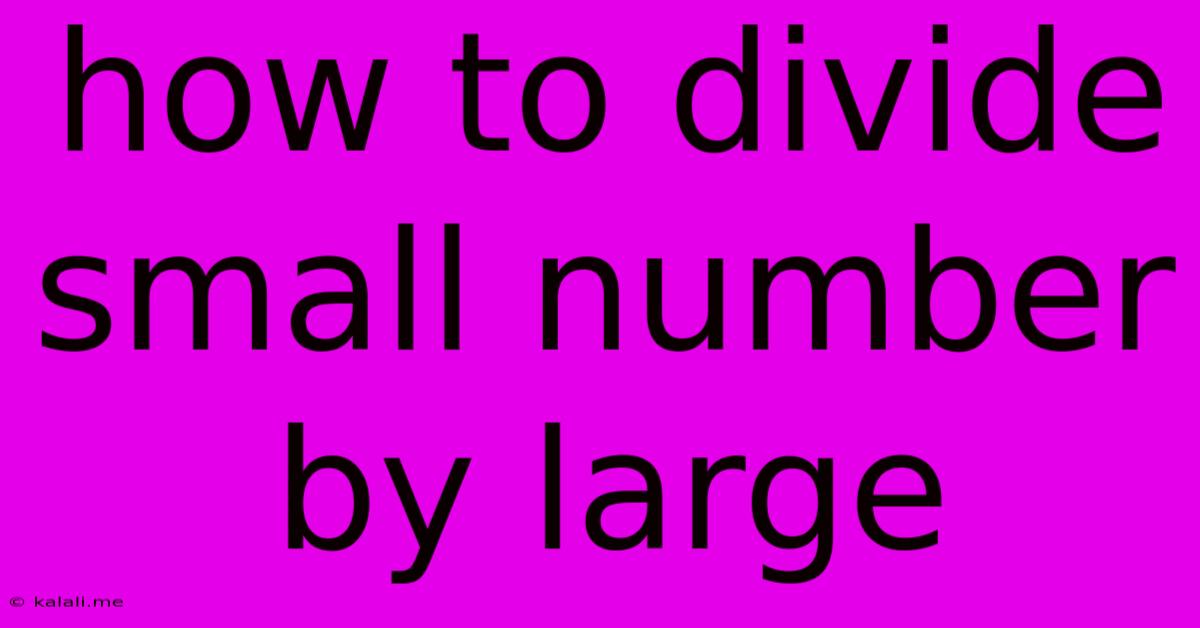How To Divide Small Number By Large
Kalali
May 22, 2025 · 3 min read

Table of Contents
How to Divide a Small Number by a Large Number: A Simple Guide
Dividing a small number by a large number often results in a decimal or fraction less than one. While seemingly straightforward, understanding the process and the implications can be beneficial, especially when dealing with percentages, ratios, or scaling problems. This guide will walk you through different methods, from using a calculator to understanding the underlying mathematical concepts.
Why is this important? Understanding this type of division is crucial in various real-world applications, including calculating percentages (e.g., what percentage of 1000 is 5?), determining ratios (e.g., the ratio of men to women in a group), and scaling down measurements (e.g., converting a large recipe to a smaller serving size). Mastering this skill improves your mathematical fluency and problem-solving capabilities.
Method 1: Using a Calculator
The simplest and quickest method is using a calculator. Simply input the small number, followed by the division symbol (÷ or /), and then the large number. The calculator will directly provide the decimal result. For instance, dividing 5 by 1000 (5 ÷ 1000) yields 0.005. This method is ideal for quick calculations, especially when precision is paramount.
Method 2: Long Division (For Understanding)
While a calculator provides the answer directly, long division offers a deeper understanding of the process. Let's illustrate with the example of 3 divided by 20 (3 ÷ 20):
-
Set up the long division: Place the small number (3) inside the long division symbol and the large number (20) outside.
-
Add a decimal point and zeros: Since 20 doesn't go into 3, add a decimal point to the quotient (the answer) and add zeros to the dividend (the number being divided).
-
Perform the division: Now, perform the long division as you would with whole numbers. 20 goes into 30 once (with a remainder of 10). Continue adding zeros and dividing until you reach the desired level of accuracy or a repeating pattern emerges. In this case, 3 ÷ 20 = 0.15.
This method, although more time-consuming, provides a clear visual representation of the division process and is helpful for grasping the concept.
Method 3: Converting to Fractions
Dividing a small number by a large number can easily be represented as a fraction. Simply place the small number as the numerator (top) and the large number as the denominator (bottom). For example, 5 divided by 1000 becomes the fraction 5/1000. This fraction can then be simplified by finding the greatest common divisor (GCD) of the numerator and denominator. In this case, the GCD of 5 and 1000 is 5, simplifying the fraction to 1/200. This fractional representation can be useful for understanding the relative size and for further calculations.
Method 4: Understanding the Result
Remember that the result of dividing a small number by a large number will always be a value less than 1. This value can be expressed as a decimal, a fraction, or a percentage. Understanding the context of the problem is crucial in interpreting this result. For example, 0.005 can represent 0.5% or 1/200. Consider the units involved and how this decimal relates to the overall context of your problem.
Practical Applications and Further Exploration
The techniques discussed here are applicable in a vast range of scenarios. From calculating discounts and interest rates to determining proportions and probabilities, mastering division of small numbers by large numbers is an essential skill. For more advanced applications, consider exploring topics like significant figures and scientific notation, which are especially relevant when working with very small or very large numbers. Remember to always check your work and consider using multiple methods to ensure accuracy.
Latest Posts
Latest Posts
-
When Does One Piece Animation Change
May 22, 2025
-
Can You Make Dua On Your Period
May 22, 2025
-
Whats The Difference Between A Bar And A Pub
May 22, 2025
-
Can You Use Xbox 1 Controller On Xbox 360
May 22, 2025
-
Wire A 2 Gang Light Switch
May 22, 2025
Related Post
Thank you for visiting our website which covers about How To Divide Small Number By Large . We hope the information provided has been useful to you. Feel free to contact us if you have any questions or need further assistance. See you next time and don't miss to bookmark.